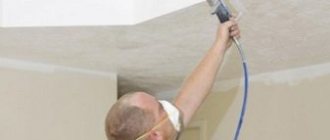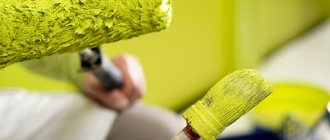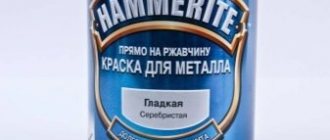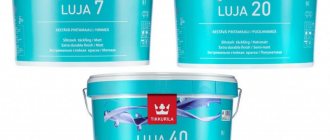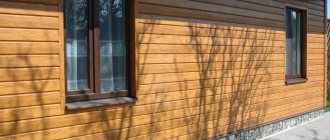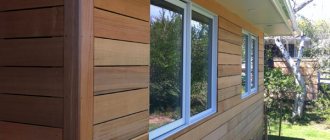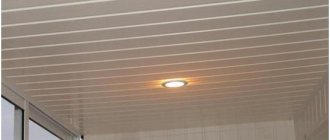In the modern construction industry there are quite a lot of types of finishes. But, along with this, painting and whitewashing of surfaces does not lose its popularity. This is due to the fact that the costs for this process are low, and the room gets a rather attractive appearance. But there are often problems with uniform application of the coloring material. A whitewash spray gun can be an assistant in this matter.
Manufacturers
Hand sprayers for whitewash have been used for quite some time.
Among the most popular models, it is worth highlighting the devices SO-20V, KRDP-5 (4). Almost all products have similar characteristics, and the main difference is the weight of the device and its cost. For a review of the SO-20V manual spray gun, see the following video.
Manufacturers of hand-held spray guns are the following domestic and foreign ones: Profmash, Auarita, Bosch, Einhell, Forte, Intertool, Miol.
Sprayers allow you to work with lime and chalk mortar in rooms where the ceiling height can reach 3.5 meters, without using additional equipment, such as scaffolding or stepladders.
The design of the sprayers is quite simple, so malfunctions are rather the exception to the rule.
The spray gun nozzle must be made of carbide raw materials, and the elements that will come into contact with aqueous solutions during operation must have a special protective coating that prevents the formation of corrosion.
Domestic products are produced taking into account all of the above nuances, and the tools also have the ability to adjust the extension for supplying paint based on the height of the working surface, which makes processing easier.
This is interesting: The subtleties of finishing a ceiling made of plastic panels
How to make your own spray gun for whitewashing
The price of industrial spray guns is quite high - from one and a half to several tens of thousands of rubles. Therefore, if you need to treat a small area once, it is more profitable to make a spray bottle for whitewashing with lime yourself.
For this you will need:
- pump with pressure gauge;
- plastic canister;
- shaft (stick of the required length);
- atomizer from a spray gun;
- long hose of small diameter;
- nipple from a bicycle tube;
- electrical tape or tape;
- drill or screwdriver;
- pliers.
Assembly begins by connecting the sprayer to the hose. To ensure secure fastening, the hose is wrapped with electrical tape. The sprayer piston is brought into the open state and secured in this position with electrical tape or tape. The sprayer is then taped to the end of the shaft. The structure should be strong and motionless. The hose is also taped to the shaft in 1-2 places with electrical tape so that it does not interfere with the work process.
Using a screwdriver or drill, make 2 holes in the lid of the canister: for the hose and for the nipple. The diameter of the first hole should be slightly smaller than the diameter of the hose to ensure tightness, and the second should be equal to the diameter of the nipple. After drilling the holes, remove the lid from the canister and secure the nipple to it using a nut. To give the structure strength and tightness, the nut is tightened with pliers. A hose is inserted into another hole and advanced to the required length so that it reaches the bottom of the canister.
The solution is filled into the canister. The lid is screwed on. The pump is attached to the canister using tape and connected to the nipple. By pinching the hose with your fingers, air is pumped into the container, bringing it to the desired pressure. After releasing the hose, the solution will begin to flow into the sprayer.
To apply a uniform layer of whitewash, it is recommended to use a spray gun at a pressure of 3-4 atm. The indicator is monitored using a pressure gauge. When the pressure drops, the air is pumped in again.
How to care for your device?
In order for the device to serve for a long time without breakdowns and the need for repairs, certain rules must be followed. Before use, you must carefully read the instructions, the information from which should be followed during operation. A mechanical spray gun may not be dangerous to humans, but if used incorrectly, it will quickly break down.
Before each use of the device, a visual inspection must be carried out. After finishing work, the device must be thoroughly rinsed and dried. This ensures that the device will last a long time. There are no parts that can quickly fail in a manual device. But the simple mechanisms that are there must be carefully looked after.
Do not overload the device. You need to pour exactly as much paint into it as indicated in the instructions. Moreover, if you plan to use an acrylic mixture, then a lubricating additive is additionally added to it.
It is also worth considering that when working with a mechanical device, a cloud with tiny particles of paint is often created
They will definitely get on everything around, so you need to take precautions. First of all, the master needs to protect his body, and especially his eyes and mucous membranes.
But do not forget that small particles of paint will remain on all objects surrounding it. Therefore, all elements that should not be painted must be removed or covered with something.
A hand-held spray gun (spray gun) is a convenient and economical device for quickly and efficiently painting walls and ceilings with water-based paint or a water-lime composition. Even the simplest devices, including those that can be made from scrap materials with your own hands, make it possible to obtain good results. But before you paint the walls, it’s worth practicing a little on unnecessary surfaces to get the hang of it and further increase the efficiency of using the device.
Instagram Templates FREE
Want to get a FREE set of templates for a beautiful Instagram?
Write to my chat assistant on Telegram below
You will receive: Free templates “Bezh”, “Akvarel”, “Gold”
Telegram Viber Vkontakte
or write “I want free templates” in direct message on Instagram @shablonoved.ru
Want to get a FREE set of templates for a beautiful Instagram?
Write to my chat assistant on Telegram below
You will receive: Free templates “Bezh”, “Akvarel”, “Gold”
Telegram Viber Vkontakte
or write “I want free templates” in direct message on Instagram @shablonoved.ru
Selection of materials for whitewashing
The ceilings are whitewashed with your own hands using a chalk or lime composition.
If the choice is made in favor of chalk, then to prepare a solution designed for 10 “squares” of surface, you will need:
- water;
- glue (PVA, Bustilat or carpentry) – 30 grams;
- laundry soap;
- chalk – 3 kilograms;
- blue – 20 grams.
Add glue and finely grated laundry soap to warm water, slowly add sifted chalk and mix all the ingredients thoroughly. To enhance the whiteness effect, add blue, dissolved in a jar of water (more details: “How to whitewash a ceiling with chalk: step-by-step instructions”).
The second option for decorating the ceiling is whitewashing with lime. This material is chosen because it has the ability to seal small cracks and has bactericidal properties.
For 10 “squares” of ceiling surface you will need:
- water;
- lime - 1.7 kilograms;
- blue – 40 grams.
In order for the solution to be of high quality, you need to check its consistency. A metal rod is lowered into the prepared whitewash. If the mixture is liquid, then the solution drains from it without a trace. Make it thicker by adding chalk or lime in small portions.
Peculiarities
When the question arises about finishing work regarding the ceiling in a room, there is a need for a convenient and effective tool that will help solve this problem.
When planning to whitewash a ceiling or walls, you can use a roller or brush, but treating the surface in this way will take a lot of time, and the process itself will be fraught with discomfort and various difficulties.
In order to optimize and facilitate such work, special devices for painting surfaces are available on the modern market. They are called spray guns, some call this product a spray gun, a spray gun, and so on. The spray gun is available in manual, pneumatic and electric types.
The main feature of working with painting guns is the level of safety that they provide to the master, because everyone knows that lime mortar is quite caustic, and therefore can cause burns upon contact with human skin. When using a brush, such cases arise very often, and using a spray gun eliminates the presence of such unpleasant situations during finishing work.
Using a mechanical spray gun for whitewashing does not require a stepladder, since the special fishing rods included in the device will make it possible to paint ceilings and corners between the ceiling and walls while being on the floor.
Hand tools will save time on painting as they are powerful enough to cover a large work area, working on a principle that allows you to paint substrates with minimal mess and splashes.
The standard type of mechanical device for whitewashing is a small-volume container into which a coloring composition, lime, chalk solution or any other liquid substance is pumped.
The main component of the tool is attached to the reservoir - a handle with a button that controls the progress of spraying the composition, the angle of application and intensity. In addition, the spray gun is equipped with a nozzle from which the solution exits onto the base.
Today on sale you can find a large number of modifications of mechanical tools used for whitewashing; they differ in their design characteristics and cost.
For industrial purposes, hand sprayers are rarely used; their main area of application is operation in private houses and apartments.
Another model of hand-held spray guns is considered to be a piston tool; it is notable for its size and a slightly different principle of performing the work.
In such a device, air injection is performed in the same way as a conventional pump when inflating. The cylinder contains several hoses, one of them is connected to a container containing a composition for treating bases.
The second hose has a sprayer at the end; it is an elongated metal tube with a button and a nozzle.
The advantages of manual sprayers include the following qualities of the tool:
- simple configuration - the spray gun is very easy to disassemble, which allows, if necessary, to replace any part that has become unusable;
- ease of use - any master can regulate the flow of the composition, even a person with minimal experience;
- hand sprayers are universal devices that are suitable not only for working with lime and chalk, but also any other type of dye for substrates - the tool is recommended for use with any finely dispersed coloring compositions;
- the products have a low cost; the pneumatic spray gun is considered the most expensive device;
- the applied composition lays down in an even layer;
- there is no need to use additional devices in order to process hard-to-reach parts of the base.
Model rating
Due to the fact that there are currently a large number of different whitewash spray guns on the market, it is very important to make the right choice of the required model. A rating of the most popular and in-demand devices from well-known brands can significantly help with this. They differ from each other in technical characteristics, functionality and appearance.
BOSCH PFS 5000 E
In this electric model, the process of air injection occurs using a remote device. It is connected through a hose to a special sprayer in the form of a liter jar. The performance of this device is good. It can be adjusted using a special system. The limitation is the use of more than 5 liters of paint per minute.
The material used for whitewashing can be either liquid or very thick. In order to use such substances, two different attachments are provided.
The spray gun has a high degree of ergonomics. The manufacturer used comfortable Softgrip pads on the device. The device was also additionally equipped with the ConstantFeed system. It ensures consistent performance of the model, no matter what angle it is used at.
The advantages of the BOSCH PFS 5000 E spray gun include such features as:
- Good ergonomics.
- Versatility of use.
- High level of productivity.
The disadvantages of the tool according to users are:
- Inconvenient launch.
- Significant cost.
Despite the high price, the model fully corresponds to it with its technical characteristics.
WAGNER W 590 FLEXiO
This electric model is a monoblock spray gun. Its main difference from many other devices is its small weight, which is only 1.9 kilograms. The pump power reaches 630 Watt. It is located at the back of the handle. In turn, the paint reservoir is located at the front. Thus, these two elements balance each other. That is why the brush of the master doing the whitewashing does not get very tired.
The X-Boost turbine is responsible for pumping air into the device. With its help, the spray gun can use up to 5 liters of material per minute. Each attachment comes with its own tank. That is why, when moving from one type of work to another, the master does not need to wash the tools.
They are slightly different from each other:
- Standard – universal with average performance.
- Wall Extra I-Spray – special for treating large surfaces.
Buyers include the following advantages of the tool as:
- High level of usability.
- Possibility of quickly replacing nozzles along with material tanks.
- Good degree of performance.
The disadvantages of the device are as follows:
- Problems with the power button.
- The cost is above average.
This model of spray gun is one of the most popular on the market recently.
BLACK+DECKER HVLP400
This electrical device is equipped with a remote pump. A distinctive feature of this model is that it has a fairly long hose that reaches 6 meters. The power of the device is not very high - only 450 W. That is why, if painting of large surfaces is required, the work may take longer.
An eye-catching feature of the tool is its convenient refilling. This is done through the side cap in the tank. That is why the master does not need to remove the tank during the process and try to find a place for the gun with the paint material flowing from it.
The spray quality of this spray gun model is quite good. It can be used to work with antiseptic or water-based paint. These functionality and technical characteristics declared by the manufacturers fully justify the cost of the spray gun, which is also lower than the price of previous models.
The main advantages of this device:
- High level of refueling convenience;
- Small overall dimensions;
- Light weight.
The disadvantages of the tool include such features as:
- Low degree of productivity;
- Low power.
The cost of this model is much lower than the first two spray guns in this rating.
FIOLENT KR1-260
This electric model allows you to use almost all types of paints intended for application using the airless method. The device is designed to operate at temperatures from +1 to +40 degrees Celsius.
The model allows you to work with both liquid and thick paints. In this case, the viscosity of the latter should not be higher than 80 DIN. The maximum performance level of the spray gun is 260 milliliters of material per minute. The power of the device is very low - only 60 W.
As a result, this electric model is the cheapest of the ones presented above.
Main advantages:
- Ergonomic handle.
- Good quality plastic parts.
- Affordable price.
- Possibility to use various materials for whitewashing.
The disadvantages of the model that buyers pay attention to are mainly the following:
- Low power.
- Poor performance.
This device is not suitable for painting large areas.
HUBERTH R500
This model from the Chinese manufacturer is a pneumatic device. It does not require a powerful compressor with a large receiver to operate. A distinctive feature of the device is minimal loss of ink material. This is important not only because it helps to save the master’s financial resources. No significant paint loss requires equipment indoors during good extraction work.
The manufacturer produces nozzles from 1.3 to 1.7 millimeters in the kit for the pistol. Additionally, buyers have the opportunity to purchase replacement kits. Thus, with one spray gun you can perform several jobs at once, easily changing attachments.
Many important parts are made of stainless steel.
The compressor for this spray gun must have the following technical characteristics:
- Pressure: 2.5 to 3 bar.
- Maximum flow: 110 liters per minute.
The main advantages of this pneumatic model:
- Not very high technical requirements for the compressor.
- Needles and nozzles are made of stainless steel.
- Good quality paint application.
The disadvantages of the device are as follows:
- Poor paint job on the gun itself.
- Relatively high cost.
This model is currently enjoying good popularity among buyers.
Metabo FSP 600
This pneumatic spray gun is distinguished by its convenience and ease of use. It does not require a very powerful compressor - just 4.5 bar of pressure is enough. The air flow in this case will be 240 liters per minute. The nozzle used in this device has a diameter of 1.5 millimeters. You can use it to paint a fence. In turn, such a device is not suitable for applying paint to a car. It is best to purchase a nozzle with a smaller diameter than what comes with the kit.
Experts include the following advantages of the model:
- Optimal ratio of cost and quality.
- Not very high technical requirements for the compressor.
The disadvantages of the device are as follows:
- Lack of a set of various standard nozzles suitable for all types of work.
- The need for a hood in the garage when painting.
This model has good demand in the market.
FUBAG MASTER G600/1.4 HVLP
This spray gun is characterized by a very low cost. It is equipped with a nozzle whose diameter is 1.4 millimeters. To operate, the device requires a compressor that is capable of producing a pressure of 3.5 bar. The producer in this case will be 180 liters of air per minute.
Due to its design features, the spray gun requires work to be carried out from a fairly close distance to the surface. That is why, without special skills in its operation, there is a risk of drips.
The advantages of the model are as follows:
- Minor paint spray to the sides.
- Not very high technical requirements for the compressor.
The disadvantages of the device are:
- Average level of reliability.
- Low quality of painting.
This amateur spray gun model is not suitable for professional painting of surfaces.
Precautions and preparation
When using a spray gun to paint ceilings, be sure to take care of safety. When sprayed, tiny particles of paint will end up in the air, after which they will settle not only on the floor and other surfaces, but also get into your eyes and lungs. Despite the fact that ceiling paints contain practically no harmful substances, inhalation is still dangerous, the same applies to the eyes
It is clear that working in a respirator is not so convenient, however, this cannot be neglected. If you don’t have a respirator, a regular cloth or gauze bandage will do. Also, stock up on glasses, so the paint will not get into your eyes. Before painting, the room must be cleared of furniture, and anything that cannot be removed must be covered with film. If you are only repainting the ceiling, cover the walls with polyethylene, securing it with masking tape.
Now you need to prepare the paint. As a rule, the packaging always contains the manufacturer’s instructions, which indicate the exact proportions. But it happens that there are no such instructions, then you will have to thin the paint intuitively. The optimal thickness is determined by each artist separately, but the paint should not be very thick, nor too thin. It is best to spray a little diluted paint on some surface, but not on the ceiling! This way you will see how well the paint sprays and adheres, whether it needs more thinning, or is it already enough.
After diluting the paint, be sure to filter it, because the slightest particles of debris, dry paint or clumps can clog the sprayer and leave unsightly marks on the ceiling. This point is very important: without filtration, painting the ceiling with a spray gun can take a long time and cause a lot of problems.
Pneumatic device
Lime whitening of ceilings can be done using pneumatic models. Professional builders prefer such devices.
A pneumatic spray gun is mainly used for painting large areas. It differs from the manual model in the mechanism responsible for maintaining the required pressure in the tank.
For this purpose, there is a compressor that provides constant pressure. This allows the stream to come out without interruption. And the result is an immaculately painted surface.
There is no need for such spray bottles if they are to be used rarely. Since they are more expensive than manual models and rare use does not justify such a purchase. The main advantage is their high performance.
The device works thanks to the air pressure created by the compressor. A lime or other coloring solution is supplied through the spray nozzle under high pressure.
And since this pressure is continuously present, the finely dispersed composition is applied to the surface easily and evenly with a sprayer.
If you follow all the rules for using this type of device, then in a short time you can see an ideal surface that does not have:
- excess solution;
- leaks;
- divorces.
Advantages of using an airbrush
When starting whitewashing work, problems constantly arise such as how to carry out the process without lime corroding your hands, causing smudges and smears on the surface. A whitewash sprayer can virtually eliminate all unpleasant moments and make the whitewashing process less problematic. The advantages of a whitewash spray gun include:
- Distribute the lime layer evenly on the surface to be painted.
- Possibility of painting hard-to-reach places without causing splashes or drips. This is especially true for corner places.
- There is no need to carry stepladders and sawhorses to reach the ceiling surface.
In addition to the main factors, we can also name such as improving conditions and increasing the speed of work performed. In a fairly short time, you can cover a fairly large area of the surface to be painted. The work is especially easier when whitewashing the ceiling with lime. This is a problematic part of the room, which you always have to tinker with. When whitewashing by hand, you have to apply several layers. The sprayer can handle this job in one go, and as a result we get a high-quality painted ceiling surface without streaks.
Hand spray guns
They are used for spraying whitewash and water-based paint on a small finishing area. The productivity of a hand-held spray gun is low - up to 250 m2 per hour. The working pressure is also low - up to 0.6 MPa, so the devices are not designed to work with viscous compounds - varnishes, putty. Hand spray guns can be used to apply liquid antiseptic or fire retardant, as well as to treat garden crops against pests.
A hand-held spray gun is shown in the illustration. The paint in it is supplied using a plunger pump located in a cylindrical body. The pump is controlled using a handle: the painter's assistant moves it up and down.
Manual spray gun KROS-1M
At the bottom of the body there is a reservoir for the coloring mixture; two hoses are connected to it - suction and pressure. When the pump rod moves upward, a vacuum is created inside the tank, due to which paint is drawn from the outer tank through the suction hose. To prevent clogging of the spray gun with solid particles, the end of the hose is equipped with a filter. To prevent backflow of paint, a suction valve is provided in the tank.
When the rod moves downwards, excess pressure is created inside the pump, and paint from the reservoir is supplied through the pressure hose to the fishing rod. At the end of the rod there is a nozzle with which you can adjust the spray angle. At its other end there is a shut-off valve - trigger. The fishing rod consists of two parts, allowing you to change its length, which is convenient when painting the ceiling.
Scheme of working with a manual spray gun
Advantages of hand-held spray guns:
- low price;
- simple design, reliability;
- no need to connect to the electrical network or compressor;
- the presence of a long fishing rod that allows you to paint the ceiling without a stepladder.
The disadvantages include the fact that the device:
- has low productivity;
- we require at least one assistant;
- Not suitable for all types of paints and varnishes.
Technical characteristics of manual spray gun SO-20V
The procedure for applying whitewash to the ceiling
The technology for applying solutions or paint does not require the use of complex equipment for whitewashing the ceiling.
When the work is done with a brush, as in the photo, the first layer is placed perpendicular to the window openings, and the final layer is parallel to them (read: “White the ceiling with your own hands: easy and economical”). This prevents the appearance of streaks.
Using a roller greatly simplifies the whitewashing process:
- the solution or paint is poured into a container;
- the roller is dipped in whitewash and rolled along the bottom of the pallet;
- layers are first applied towards the light source, and then parallel to the windows;
- the strokes are made with an overlap of about 5 centimeters - this will avoid unpainted areas of the surface. Use a brush in hard-to-reach places.
If the area of the room is large, a device for whitewashing the ceiling is used - a spray gun - it can be manual, pneumatic or electric.
Water-based paint is a great alternative to chalk and lime as it wears more evenly and leaves the surface looking nicer. The second layer of water-based emulsion is applied perpendicular to the first after it has completely dried.
How to whitewash a ceiling, detailed video:
Spray painting
It is better to start whitewashing from the ceiling, namely from its corner. Despite the fact that the whitewash tool provides a fairly uniform layer the first time. Still, it is recommended to perform staining in two passes. The first layer should be denser. After applying it, let it dry thoroughly. After which we proceed to apply the second, but less dense. The advantages of this coloring method are:
- hiding all imperfections, both of the ceiling surface itself and of layers of paint;
- longer service life.
If, despite all the efforts, the whitewashing is completed with some errors, then do not be upset. After all, when whitewashing by hand, you get a lot more flaws and a lot more labor costs. All comes with experience. It is worth practicing several times and the result will not be long in coming.
If you follow the above recommendations when working with a spray gun, then even a beginner can get a high-quality result.
Criteria for choosing a tool for whitewashing
When choosing a spray gun, they are guided by the following criteria:
- Price. The most expensive are pneumatic models, the cheapest are electric. When making a paint sprayer with your own hands, the cost of materials will be minimal.
- Ease of use. The tool should be light, compact and easy to transport. The sprayer should be located on a long rod to facilitate the treatment of hard-to-reach places and surfaces located at high altitudes. This is especially important when whitewashing trees with a spray gun.
- Tank volume. For whitewashing large areas, it is advisable to choose a device with a large tank. The prepared solution should be enough to cover the entire surface area at one time. If you have to mix new portions of the solution several times during the work process, the coating may turn out to be uneven in color and thickness.
- Possibility of use in various conditions. Electric and pneumatic spray guns require a power source in the form of an electrical outlet. It may be difficult to operate these devices outdoors. Mechanical devices, on the contrary, can be used under any conditions.
- Uniformity of the jet exit from the nozzle. This factor is important to ensure uniform distribution of the solution over the treated surface. When using pneumatic devices, the pressure is maintained at a constant level using a compressor, and the jet comes out continuously. When working with manual paint sprayers, you must independently monitor the pressure and periodically increase it by pumping air in with a pump. Due to the gradual drop in pressure during operation, the solution stream is uneven. This affects the quality of the resulting coating.
- The quality of the resulting coating. The smoothest coating can be obtained when working with pneumatic devices. When using a hand spray gun for whitewashing, smudges and unevenness are possible.
- Device service life. It depends on the type of spray gun and the manufacturer. Mechanical devices are considered the most reliable, and electrical ones are considered the most short-lived.
- Possibility of repairing the spray gun. If individual structural elements break down, it should be possible to replace them with new ones.
Prevention and maintenance of a hand-held spray gun
The main rule for sprayer maintenance is timely cleaning of paint.
IMPORTANT! Immediately after use, the pump, hoses, and most importantly, the nozzles, must be thoroughly rinsed. Do not fill it with water until tomorrow, but rinse it
After that, be sure to run the working cycle with clean water, checking the quality of the spray on the nozzles. If this is not done, the thin holes will become clogged with particles of dried paint, which will become cemented and will be difficult to remove later.
Do not fill it with water until tomorrow, but rinse it. After that, be sure to run the working cycle with clean water, checking the quality of the spray on the nozzles. If this is not done, the thin holes will become clogged with particles of dried paint, which will cement and be difficult to remove later.
Then the entire system is purged with air, dried and assembled into transport position according to the instructions. The suction and pressure hose should be stored in rings. It is not recommended to hang hoses on a hard hook or nail; a crack may occur at the bend.
Before the next use, it is necessary to carry out an inspection (for visual detection of damage) and check the tightness of the seals and valves. If faults are identified, spare parts are replaced with new ones.
IMPORTANT! The spray gun must be checked long before work begins, so that an unexpected breakdown does not change your repair plans.
How to choose a spray gun?
In any hardware store you can find a wide range of similar products. Spray guns differ primarily in the type of work. Mechanical devices will cost much less than electric or pneumatic ones. Therefore, they are in great demand, although they are considered not very convenient.
Before purchasing a device, you first need to determine for yourself in what area it will be used. If we are talking about home repairs in a small apartment, you can safely purchase a manual device. It will be both more profitable and more convenient.
Mechanical sprayers may also differ slightly. First of all, this concerns the volume of the paint tank. If it is too large, it will be awkward to hold, and if it is too small, you will have to constantly add paint. Therefore, you should opt for the middle option.
Paint containers can be made from several types of material. Most often, manufacturers offer plastic and metal tanks. Both types last a long time, but plastic is lighter and cheaper, which is why such spray guns are more popular. The paint container can be located below or above the lever. This does not play a big role, and this factor does not affect the quality and ease of use at all.
A much more important characteristic is the size of the nozzle. The best option is 1.5 cm
This will allow the spray gun to work with most types of paint. If you take a smaller size, then there will be no more options other than using a spray gun for water-based paint.
Normal spray guns with average performance produce about 8 bar of operating pressure. This will be enough to work on medium surfaces and apply paint in a fairly neat and thick layer. A pressure of more than 10 bar will produce a large torch that can quickly paint large volumes, but in this case the paint is applied in a very thin layer.
If you plan to use the spray gun to work with putty, it is worth purchasing an automatic version with a wide nozzle and high operating pressure. Most often, pneumatic devices are used for these purposes.
When buying a spray gun, you need to carefully examine it, hold it to your hand to make sure that it is really convenient to use, and be sure to pay attention to the package. It is advisable that the device does not weigh too much
Otherwise, your hands will immediately get tired while working. Many devices come with additional attachments. They can be used for different types of paint, making the device more versatile. However, too many unnecessary extras will be a waste of money. Such devices will cost more than regular ones, so there is no point in overpaying for unnecessary parts.
Model selection
What kind of sprayer is needed? There are no special requirements, anyone will do. But the spray bottle is not purchased for one-time use. Therefore, it is worth considering the characteristics of all models and their application options. Paint sprayers are manual, pneumatic and electric.
Manual
The most popular type of spray gun. It is chosen by consumers who need to quickly do DIY repairs or paint small items. The advantages of manual models include the following:
- Simplicity of the device. The spray gun is easy to disassemble and reassemble, and, if necessary, replace failed parts.
- Ease of use. Even a beginner can regulate the flow of dye.
- Versatility. Suitable for almost all finely dispersed dyes.
- Low cost.
A manual spray gun for whitewashing and painting is convenient when a very large amount of work is not required (for example, when you need to whitewash the ceiling or walls in a residential building or utility rooms). A small disadvantage of the equipment is that it is necessary to manually maintain a certain pressure in the tank, otherwise the speed of the paint stream begins to drop.
Pneumatic
Pneumatic equipment for whitewashing is chosen by professionals when a large amount of work is required. It differs from the manual one in its operating principle: constant pressure of the paint jet is maintained by a compressor. Thanks to high pressure, the whitewashed ceiling looks almost flawless.
But pneumatic devices are expensive. For DIY home repairs, when the tool will not be used very often, it is not advisable to purchase them.
Electrical
If for some reason it is not practical to purchase a pneumatic spray gun, but you want to make perfect repairs, then it is recommended to pay attention to an electric paint sprayer. In it, the pressure of the ink jet is provided by an electric motor. According to reviews from home craftsmen, the quality of working with an electric paint gun is almost as good as that of a pneumatic tool.
Tips and tricks
Before purchasing a hand-held spray gun, you must clearly define the purposes for which the tool will be used. Having decided on this issue, it will be much easier to make the right choice, since the range of modern tools is quite large.
Mechanical sprayers are the most budget-friendly option for devices, pneumatic tools are highly expensive, and electrical devices belong to the mid-price category.
The device is selected based on the following product characteristics:
- volume of the solution tank;
- power;
- pressure.
Each parameter directly depends on the other - that is, a large tank will have higher productivity. The optimal pressure is considered to be 5 bar. Products most often have a tank volume designed for two liters of composition.
The new solution should be first tested on any surface before starting to treat the bases in the apartment, so you can once again make sure of the appropriate consistency of the composition. The liquid must be filtered before use. This will save time, since the sprayer will become much less clogged.
The efficiency and uniformity of the treatment will depend on maintaining the same speed of whitewash spraying. At the end of the work, the remaining liquid can be usefully used as a treatment for trees in the yard.
Preparation for using a whitewash sprayer yourself includes the following points:
- the size of the nozzle hole will determine the efficiency and correct application of the composition, so it is worth adjusting it, bringing it to the smallest size;
- to strain the solution, you should use a sieve, the cells of which will be no more than 5 mm; in addition, gauze is perfect for such tasks;
- In order to extend the service life of a hand-held whitewashing tool, regular maintenance of the device should be carried out.
In addition, after each use, the tool must be thoroughly cleaned and a detailed inspection carried out for possible defects. For these purposes, a visual inspection of all structural elements is carried out, after which the gaskets are checked, as well as the functioning of the device.
How to use the tool
The whole process can be divided into two stages: preparation of the solution and equipment and the actual application of lime to the walls or ceiling.
Preparation
Preparatory work includes the following:
- Checking the serviceability of the tool. Even if the master keeps his spray bottle in order, it is worth additionally checking the functionality of all components by filling the device with a small amount of water. After checking the serviceability, it is recommended to adjust the size of the injectors, making them minimal. This is necessary for economical and uniform application of the dye.
- Straining the solution. If this is not done, the nozzle holes on the sprayer will quickly become clogged, and the operation of the tool will become poor. You can strain the lime through a fine sieve or through gauze folded in half.
Despite the fact that using a sprayer you can avoid burns from lime mortar, the stream escaping from the nozzle not only paints the surface, but also forms a fine suspension in the air. Microscopic particles can settle on the skin, causing dryness and irritation of the skin, get into the eyes or respiratory tract, and settle on furniture. Therefore, it is recommended to work with gloves and a respirator, covering all areas of the skin with clothing.
Plastic film should be laid on the floor and furniture. Having completed the preparatory stage, you can apply lime to the walls.
Lime application
Having prepared everything you need and poured the prepared solution into the spray bottle, you should not immediately direct the stream at the ceiling or wall; it is better to try it on a piece of unnecessary cardboard: there may be air in the nozzle, and instead of a stream of paint, uneven “spit” will appear. Compared to paint and varnish products, wet lime can be easily removed with a wet cloth, but professionals still recommend adjusting the tool on an unnecessary piece of material. After adjusting the device, you can begin to work, observing the following rules:
- When painting walls, keep the spray gun perpendicular to the surface, and when painting the ceiling, the angle should be 60-70°. You cannot “shoot” the jet directly at the ceiling - the solution is liquid, and the jet will slightly smear the painted areas located on the periphery.
- You need to move the tool smoothly, without stopping in one place.
- It is recommended to start painting from the corners, painting them with spiral or longitudinal-transverse movements.
- The first layer is applied as thinly as possible. It’s not scary if the darkening material of the wall is slightly visible through it in places - after applying the second layer everything will disappear and the surface will become white, like a sheet of paper.
It didn’t work out the first time, and the layer turned out with errors? Then it’s worth remembering how many times you had to paint over the stains left by the brush. A little experience and everything will work out. The third layer will most likely provide an ideal result.
If you use a spray gun for whitewashing with lime, then even a novice master can get an excellent result.
Benefits of the tool
A hand-held spray gun is a fairly versatile device. They can not only cover relatively large surfaces with paint. Using this simple device, vegetable and berry bushes and fruit trees are sprayed, adhesive and cleaning solutions are applied, premises are disinfected, and flammable surfaces are impregnated with fire retardant compounds.
For whitewashing with lime, this is generally an indispensable tool. When painting by hand with a brush, it is necessary to carefully protect the remaining surfaces, since slaked lime is a rather aggressive liquid. The nozzle for the spray gun applies the composition evenly and accurately. With proper adjustment, there are virtually no streaks or stray painted surfaces.
This is done so that the whitewash does not smear over time and lasts longer.
The most suitable use for a hand pump is for painting the ceiling. This type of painting work is usually associated with various kinds of difficulties. To apply paint evenly, you need to quickly move around the room, and doing this with a stepladder is quite difficult. It is especially difficult to reach every corner if the ceiling is more than 3 meters high.
The pressure created by the pump produces a powerful spray of paint at the outlet of the sprayer, which evenly covers the horizontal surface of the ceiling from a distance of up to one and a half meters. How to use a hand spray gun correctly?
- Half the success lies in the correct preparation of the coloring solution;
The viscosity must exactly correspond to the instructions for the selected sprayer. It is better to stir the paint using a mixer (a drill with an attachment is quite suitable). Before use, the solution can be filtered through a sieve or cheesecloth. Despite the filter included in the suction hose, there should be no solid particles or uneven fractions in the solution.
Before starting work, the pump should be pumped to bring the valves into working condition (natural sealing method);
It is necessary to pump approximately 500 ml of solution into the pump. Then remove the suction hose filter from the container and make 10-20 idle working movements of the rod. In this case, the pump valves will undergo a self-regulation procedure. After this, the intake filter is again immersed in the solution, and with vigorous movements of the rod we bring the pressure in the system to the required value.
Then the spray pattern is adjusted;
To do this, you need to simulate the conditions under which you plan to paint. In the same room (subject to maintaining humidity and temperature) a test surface, for example made from old wallpaper, is placed. A training layer of paint is applied to it from a fixed distance. By adjusting the nozzle nozzle, working pressure and solution viscosity, the optimal option is selected.
To ensure continuity of paint application, it is preferable to work together;
In the video, the master shows how to whitewash walls and ceilings with a spray gun.
In this case, you will not have to interrupt the process and be distracted by periodically pumping up the working pressure.
Painting is done from the corners, then the sprayer is moved in a spiral so that each next layer overlaps the previous one;
The first layer is applied more densely, but without the formation of smudges. After final drying, the second, final layer is applied. It should be less “fat” and is intended rather to correct the flaws of the first layer.
The room temperature should be within 15-30 degrees above zero, humidity no more than 50%; The painter and his assistant must be protected from paint coming into contact with exposed areas of the body, and if the paint contains synthetic solvents, they must use a respirator.
Rules for using the spray gun
It's time to consider in detail the rules for working with a spray gun. To obtain high-quality surface painting, you must adhere to certain recommendations of the masters.
Preparation of the solution
Consumers may object, because preparing a coloring composition is not working with a spray gun. To some extent, they are right, but the smooth operation of the instrument depends on how correctly the dye is prepared. Some tips:
- The dye must be prepared strictly according to the instructions. Its consistency should not be too thick. Otherwise, it will clog the system too quickly.
- Check the solution for lumps. Therefore, it is better to use a construction mixer to mix the composition.
Advice! In order to ensure a high-quality filtration process, the lime mixture is passed through a sieve, which has a mesh size of maximum 5 mm. You can also use “grandmother’s” method - strain through cheesecloth.
Pump adjustment
Before starting work, it is advisable to adjust the pump. It is better to do this by forming a stain on the surface. The test is carried out on a surface that will not be painted. Because otherwise you will have to smooth the layer. Ideally, it will be a piece of wallpaper that is not suitable for use. They are attached to the wall in such a way that their surface is perpendicular to the sprayer. We adhere to the distance from the wallpaper at which we plan to carry out all subsequent work.
It is recommended to adjust the pump according to the following parameters:
- We begin spraying paint in a clearly defined direction until we get a uniform spot and drips appear along the edges. In this case, it is necessary to make adjustments.
- If smudges have formed and the stain is not sufficiently uniform, it is necessary to reduce the degree of air intake.
- If smudges appear in the center of the spot, then the air supply should be increased.
- In the case where the stain is formed unevenly, the viscosity of the solution should be reduced.
In addition to this, pay attention to the size of the spray rod. A uniform and economical spraying method is achieved with minimal diametrical cross-sectional dimensions.
On the video: features of the spray gun settings.
Pneumatic spray gun
The tool is much more expensive than the manual model, but also has high performance. Ideal for whitewashing large surfaces. Following the recommendations and rules for applying lime with a pneumatic spray gun allows you to get perfectly whitewashed ceilings and walls, free of stains and stains, in the shortest possible time.
The principle of operation of the device is based on the injection of air by a compressor, through which a solution is supplied under high constant pressure through a nozzle in the sprayer. The result of this is the ingress of finely dispersed composition onto the surface being processed. The layer is applied evenly and efficiently. No smudges, streaks, or application of excess solution. Whitewashing with a tool is carried out quickly, efficiently and with minimal labor costs.
How the airbrush works
All types of spray guns work according to the same principle:
- The cylinder is filled with lime mixture and the required pressure is achieved through a special hose using a compressor or electric motor.
- The solution is pressurized into the built-in distribution hose and then into the paint spray wand.
Important! Some models have a special adjustment tool that can change the spray radius of the solution.
